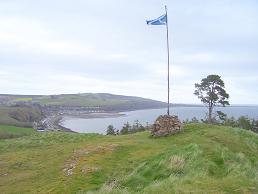Ormond Castle
 Ormond Castle, also known as Avoch Castle, was a powerful
stronghold, overlooking the village of Avoch, on the Black Isle, in
the former county of Ross and Cromarty, now part of Highland,
Scotland.
Ormond Castle, also known as Avoch Castle, was a powerful
stronghold, overlooking the village of Avoch, on the Black Isle, in
the former county of Ross and Cromarty, now part of Highland,
Scotland.
It is conceivable that it was one of the two
castles known to have been erected during the reign of William the
Lion on the Black Isle, as royal fortalices.
By the
thirteenth century, the castle was in the hands of the de Moravias
of Petty and was where they ruled their vast tracts of land across
Moray. Andrew de Moravia mustered the men of Moray to join King John
Baliol at Ormond Castle following his dishonour in front of Edward I
of England, at the outset of Wars of Scottish Independence.
The heiress to the de Moravias of Petty was Joanna of Bothwell, in
1362 she married Archibald the
Grim, Lord of Galloway and later 3rd Earl of Douglas who claimed
her estates and titles de jure uxoris (by right of marriage). Ormond
Castle was the caput of the Barony of Ormonde, and was created into
an Earldom in 1455 for Hugh Douglas, Earl of Ormonde, third son of
James Douglas, 7th Earl of
Douglas. Following the fall of the Black Douglases after the
Battle of Arkinholm in 1455
and the execution of the earl, his properties, like those of his
brothers, was forfeit. Ormond Castle was taken by the crown and
regranted to George Douglas, 4th
Earl of Angus. Angus, the "Red Douglas", was a kinsman and enemy
of the Black Douglases, and became the new power from that mighty
house. The title of Earl of Ormonde was recreated for the elder son
of the 1st Marquess of Douglas in 1651, but became extinct upon the
death of Archibald Douglas, 3rd Earl of Ormonde in 1715, who died of
wounds following the Battle of
Sheriffmuir.
In 1568 Ormond Castle and the lands of
Suddie in Avoch were acquired under feu from the Earls of Angus and
Ormonde, by Andrew Munro, 5th of Milntown, also known as Andrew
Munro of Newmore during his father's life time.
Ormond Castle
was destroyed in the 1650s by Oliver Cromwell, in order for him to
build his fortress at Inverness. Only ruins of the castle remain
today
See also:
• Earl
of Ormond


